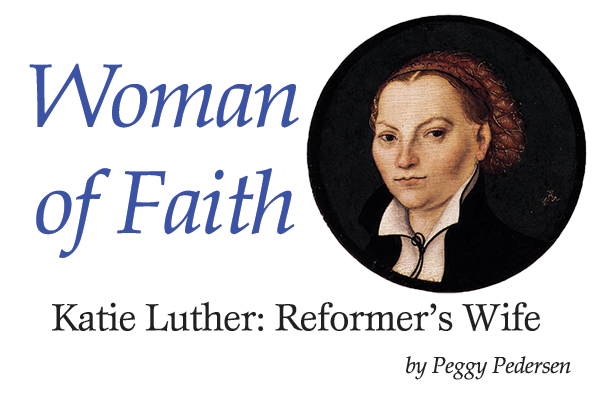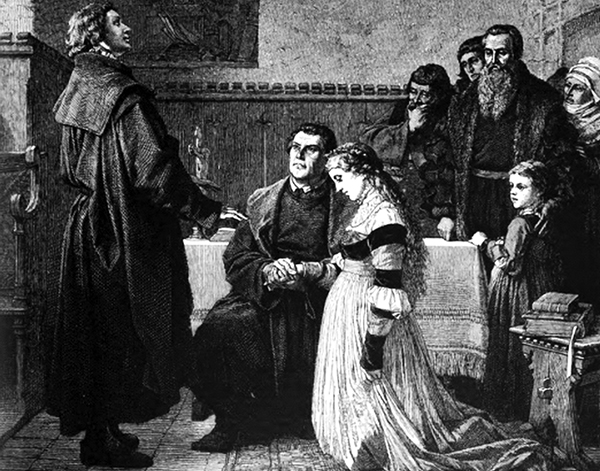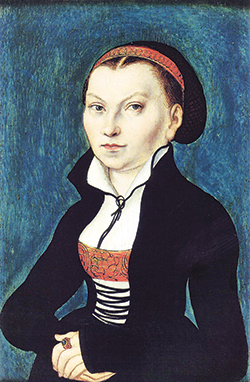Woman of Faith—Katie Luther: Reformer’s Wife

by Peggy Pedersen
“I will cling to Christ as a burr clings to a coat!” With these words, Katie Luther gave up her breath to the Lord.
On January 29, 1499, she had been born to an aristocratic family of diminished means and given the name Katharina von Bora. Little is known of her early life, even her place of birth — likely in Meissen or Lippendorf, Germany— except that she had several brothers and possibly a sister. As in other Catholic families, Katharina was baptized shortly after birth, joining her to the body of Christ.
At five, her parents enrolled her in the Benedictine school in Brehna, Germany, where her aunt Magdalena was a cloistered nun and where she would have received the best education available for girls of her class. The Benedictines encouraged education, and their schools were noted for their academics. When Katie’s father remarried, he did not bring her back to the family but transferred her as a teenager from Brehna to the Cistercian convent at Nimbschen, bordered by forests and a river with fields, gardens and a pond. Katharina took vows as a nun seven years afterward, possibly upon losing her parents.
Although she led a regulated life of prayers, masses, and work embroidering altar cloths and tending the garden, outside news would still arrive through family visits, tradesmen, and letters from friends and relatives. The news those days was of great moment and interest. One of the nuns, Magdalene von Staupitz—niece of Johann von Staupitz, vicar-general of the Augustinian order and Martin Luther’s superior—gathered a group of nuns and secretly disclosed news of Luther’s teachings, including his stunning injunction: “Your vow is contrary to God and has no validity; don’t delay but get married.”
As the Reformation gathered adherents, it was impossible to be unaware, even within a convent’s walls, of dramatic changes effected by Luther’s words, even during his mysterious disappearance. The nearby monastery of Grimmen closed, vows of celibacy were annulled, and churches were sacked. When Luther returned from hiding, Magdalene von Staupitz wrote to him, pleading that he free nine nuns from the confinement of their cloister; neither guardians nor parents had been willing to receive them. Luther arranged with a city councilman from Torgau for their daring rescue on Easter evening, hidden between the merchant’s herring barrels.
The Nun Marries
The women were settled in new homes through marriage or as housekeepers in wealthy homes. Katie lived for a time in the home of the burgomaster and later with the family of artist Lucas Cranach the Elder, who painted her portrait. She continued studies at the university and wanted to wed fellow student Hieronymus Baumgaertner, but his parents refused permission for him to marry a runaway nun. When all attempts to find her a husband failed, though she had other suitors, she stated that she would only consider Luther.

Martin Luther and Katharina von Bora marry. (Image from Die Gartenlaube, 1872).
Truthfully, neither she nor Luther had expected to be married. At 26, Katie was past the then usual age for women to marry, and Luther seemed wedded to the Reformation. Yet Luther, at 42, had developed fondness for her, referring to her as ‘my Katie.’ “Everything created by God is good,” he taught, “and nothing is to be rejected if it is received with thanksgiving, for it is made holy by the word of God and prayer” (1 Timothy 4:4-5). He thought the reformists’ cause would advance by encouraging marriage, and—despite his friend Philipp Melanchthon’s strong objection—he married her in June of 1525. He wrote: “I feel neither passionate love nor burning for my spouse, but I cherish her.” But married love would grow; he later wrote: “My Katie is in all things so obliging and pleasing to me that I would not exchange my poverty for the riches of Croesus.”
“My Katie is in all things so obliging and pleasing to me that I would not exchange my poverty for the riches of Croesus.”
Martin and Katharina made their home in a former Augustine monastery and settled into a very busy life. An excellent household manager, she cooked for their six children, four adopted children, and the many students and visitors who boarded with them. She also raised livestock and operated a brewery, a hospital, and a small farm at Zolsdorf. Luther called her ‘the Morning Star of Wittenberg,’ as she arose at 4 a.m. to carry out her duties. Her brewing skills were greatly appreciated, with Luther once noting: “My Katie has brewed fourteen tuns, in which she has put 32 bushels of malt to suit my taste.”
As only eight of her letters still exist, most of what we know of Katharina comes from Martin Luther’s letters. Both of them saw marriage as a school of character with many adjustments. In his Table Talk, he praised her: “The greatest blessing that God can confer on man is the possession of a good and pious wife with whom he may live in peace and tranquility; to whom he can confide his whole possessions, even his life and welfare, and who bears him children. Katie, thou hast a pious man who loves thee for a husband; thou art a very empress, thanks be to God.”
She was solicitous of her husband and guarded his times of prayer and study, nursed his infirmities, mothered his students, cheered him in dejection, and worried about him when he travelled. They helped each other focus on God, despite life’s troubles. One day, when Luther was depressed, Katie put on a black dress. Luther asked her: “Are you going to a funeral?” “No,” she responded, “but since you act as though God is dead, I wanted to join you in the mourning!”
Luther chided her for worrying about him, writing in one letter: “To my dear wife, Katharina Luther, doctor’s spouse in Wittenberg, keeper of the pig market, and gracious wife whom I am bound to serve hand and foot: grace and peace in the Lord. Dear Katie, you should read the Gospel according to Saint John and the Small Catechism, of which you once said, ‘Everything in this book has to do with me!’ You are worrying in God’s stead as if He were not almighty…. I have a better worrier than you and all the angels. He lies in a cradle and clings to a virgin’s breast, and yet He is at the same time seated at the right hand of God the Father Almighty. Therefore be satisfied. Amen.”
Katie’s favourite psalm was Psalm 31, which she committed to memory at Luther’s urging: “It will be a comfort to you.” Indeed, at the time of her death she repeated that psalm over and over. Luther also encouraged her when she started reading the Bible. “I have promised her 50 gulden if she finishes by Easter. She is hard at it and is at the end of the fifth book of Moses.”
Her marriage was a happy one. Luther praised her highly, even referring to St. Paul’s Letter to the Galatians as ‘My Katharina von Bora.’ She was not a meek woman who lived in Luther’s shadow, but a strong partner. She and Luther argued, like all couples — often about money, for she was practical and he was generous — but she was equal to his wit.
Faith in Dark Times

Portrait by Lucas Cranach the Elder (c. 1530).
Her faith was tested in the crucible of suffering as well. She miscarried during her first pregnancy; another child died at eight months. Luther once became dangerously ill. Certain that he would die, he commended her, together with their babe in arms, to the God of widows and orphans and His gracious will, yet she comforted him with Scriptures and prayers, and he recovered. He was often sick, at times suffering from gout, insomnia, catarrh, hemorrhoids, constipation, stones and dizziness, and she expertly prepared herbal remedies and poultices.
At age 13, their daughter Magdalena took ill and died suddenly. The night before her death, Katharina had dreamed of two shining youths who asked for her hand in marriage, which Melanchthon interpreted as angels inviting her to heaven. When asked if she was ready to depart, Magdalena replied: “Yes, dear father, just as God pleases.”
Four of their children reached adulthood, all remaining faithful to Christ. Hans studied law; Martin Jr., theology; Paul became a doctor; and Margarete married a Prussian nobleman.
Luther’s life was often under threat. In addition to sickness, especially in later life, he had many political enemies. After Katie begged him not to attend the wedding of his friend Spalatin, he fortunately agreed and was spared assassination. Even in his last illness, he was away from home. Katie couldn’t be at his bedside, and learned of his passing shortly after receiving his letter saying he would soon return home. Although Luther left her his estate, she failed to take his advice to sell it, and it was lost to war and taxes. Facing poverty, she had to rely on the generosity of Luther’s supporters.
“I will stick to Christ, as a burr clings to a coat.”
When war broke out, Katie fled to Magdeburg and later to Braunschweig. Returning after the war, she found the home and land devastated and the livestock gone. She again had to flee when the plague threatened Wittenburg; on the way to Torgau, her carriage overturned, throwing her into a cold, filthy ditch. She did not recover from her injuries and died three months later. During this time, she repeated Psalm 31 over and over, and on her deathbed said: “I will stick to Christ, as a burr clings to a coat.”
Woman of Faith
From her baptism through convent life, serving her husband and his ministry, raising children, showing hospitality and faithfully carrying out her duties, Katharina perfectly demonstrated Christian vocation. One is reminded of Proverbs 31:10–31. Verse 28 reads: “Her children arise and call her blessed; her husband also, and he praises her.”
This extraordinary woman inspires us, for life is a long, unforeseen way for each of us. It is a way of the Cross, yet a way of blessing. Scripture tells us: “Blessed is the one who remains steadfast under trial, for when he has stood the test he will receive the crown of life, which God has promised to those who love him” (James 1:12).
Through adversity and need, acquainted with joys, tragedy, and grief, Katie exhibited deep trust in Christ as her strength. As the burr clings to the cloth, she clung to Him; but as the cloth entangles the burr, He held her firm to Himself — just as He will hold each of us who put our faith in Him.
———————




